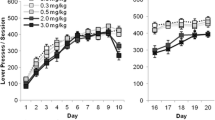Abstract
The similarity in the pattern of responding produced by extinction and dopamine (DA) receptor blockers has led to the suggestion that DA neurons may participate in the usual effects of reward on behaviour. The purpose of the present study was to evaluate the effect of receptor-subtype specific DA antagonists on food-rewarded operant responding. Rats were trained to lever press for food on a variable interval 30-s schedule. They then received one of the following treatments prior to testing on the next 5 days: saline, nonreinforcement, the DA receptor blocker pimozide (0.5 or 1.0 mg/kg), the D1 receptor blocker SCH 23390 (0.01, 0.05, 0.1 mg/kg), and the D2 receptor blocker metoclopramide (1.0, 5.0, 10.0 mg/kg). Nonreinforcement resulted in both intra- and intersession declines in responding. The drugs produced dose-dependent decreases in overall responding. Additionally, both doses of pimozide and the higher doses of SCH 23390 and metoclopramide altered intrasession patterns of responding when compared to saline, with their greatest effect being in the latter portion of the session. Intersession declines were seen with the highest doses of SCH 23390 and metoclopramide and control studies showed that these declines could not be attributed to a buildup of the drug with repeated dosing. It was concluded that both D1 and D2 receptors participate in the control of behaviour by reward.
Similar content being viewed by others
References
Beninger RJ (1982) A comparison of the effects of pimozide and nonreinforcement on discriminated operant responding in rats. Pharmacol Biochem Behav 16:667–669
Beninger RJ, Phillips AG, Fibiger HC (1983) Prior training and intermittent retraining attenuate pimozide-induced avoidance deficits. Pharmacol Biochem Behav 18:619–624
Beninger RJ, Cooper TA, Mazurski EJ (1985) Automating the measurement of locomotor activity. Neurobehav Toxicol Teratol 7:79–85
Creese I (1983) Receptor interactions of neuroleptics. In: Coyle JT, Enna SJ (eds) Neuroleptics: Neurochemical, behavioral, and clinical perspectives. Raven, New York, pp 183–222
Cross AJ, Mashal RD, Johnson JA, Owen F (1983) Preferential inhibition of ligand binding to calf striatal dopamine D1 receptors by SCH 23390. Neuropharmacology 22:1327–1329
Elliott PNC, Jenner P, Huizing G, Marsden CD, Miller R (1977) Substituted benzamides as cerebral dopamine antagonists in rodents. Neuropharmacology 16:333–342
Ferrer JMR, Sanguinetti AW, Vives F, Mora F (1983) Effects of agonists and antagonists of D1 and D2 dopamine receptors on self-stimulation of the medial prefrontal cortex in the rat. Pharmacol Biochem Behav 19:211–217
Gallistel CR, Davis AJ (1983) Affinity for the dopamine D2 receptor predicts neuroleptic potency in blocking the reinforcing effect of MFB stimulation. Pharmacol Biochem Behav 19:867–872
Gray T, Wise RA (1980) Effects of pimozide on lever pressing behavior maintained on an intermittent reinforcement schedule. Pharmacol Biochem Behav 12:931–935
Harrington RA, Hamilton CW, Brogden RN, Linkewich JA, Romankiewicz JA, Heel RC (1983) Metoclopramide, an updated review of its pharmacological properties and clinical use. Drugs 25:451–494
Hoffman DC, Beninger RJ (1985) The D1 dopamine receptor antagonist, SCH 23390 reduces locomotor activity and rearing in rats. Pharmacol Biochem Behav 22:341–342
Hyttel J (1983) SCH 23390 — The first selective dopamine D1 antagonist. Eur J Pharmacol 91:153–154
Iorio LC, Barnett A, Leitz FH, Houser VP, Korduba CA (1983) SCH 23390, a potential benzazepine antipsychotic with unique interactions on dopaminergic systems. J Pharmacol Exp Ther 266:462–468
Jenner P, Marsden CD, Peringer E (1975) Behavioural and biochemical evidence for cerebral dopamine receptor blockade for metoclopramide in rodents. Proc Br Pharmacol Soc, 26–27 March, pp 275–276
Jenner P, Clow A, Reavill C, Theodorou A, Marsden CD (1978) A behavioural and biochemical comparison of dopamine receptor blockade produced by haloperidol with that produced by substituted benzamide drugs. Life Sci 23:545–550
Kebabian JW, Calne DB (1979) Multiple receptors for dopamine. Nature 277:93–96
Keppel G (1973) Design and analysis: A researcher's handbook. Prentice-Hall, Englewood Cliffs, New Jersey
Mackintosh NJ (1974) The psychology of animal learning. Academic, London
Mason ST, Beninger RJ, Fibiger HC, Phillips AG (1980) Pimozide-induced suppression of responding: Evidence against a block of food reward. Pharmacol Biochem Behav 12:917–923
Nakajima S, McKenzie GM (1986) Reduction of the rewarding effect of brain stimulation by a blockade of dopamine D1 receptor with SCH 23390. Pharmacol Biochem Behav 24:919–923
Peringer E, Jenner P, Donaldson IM, Marsden CD (1976) Metoclopramide and dopamine receptor blockade. Neuropharmacology 15:463–469
Phillips AG, Fibiger HC (1979) Decreased resistance to extinction after haloperidol: Implications for the role of dopamine in reinforcement. Pharmacol Biochem Behav 10:751–760
Salamone JD (1986) Different effects of haloperidol and extinction on instrumental behaviours. Psychopharmacology 88:18–23
Schulz DW, Stanford EJ, Wyrick SW, Mailman RB (1985) Binding of [3H]-SCH 23390 in rat brain: Regional distribution and effects of assay conditions and GTP suggest interactions at a D1-like dopamine receptor. J Neurochem 45:1601–1611
Setler PE, Sarau HM, Zirkle CL, Saunders HL (1978) The central effects of a novel dopamine agonist. Eur J Pharmacol 50:419–430
Skinner BF (1938) The behaviour of organisms. Appleton-Century-Crofts, New York
Tombaugh TN, Anisman H, Tombaugh J (1980) Extinction and dopamine receptor blockade after intermittent reinforcement training: Failure to observe functional equivalence. Psychopharmacology 20:19–28
Ungerstedt U (1979) Central dopamine mechanisms and unconditioned behaviour. In: Horn AS, Korf J, Westerink BHC (eds) The neurobiology of dopamine. Academic, London New York San Francisco, pp 577–596
Wise RA, Spindler J, de Wit H, Gerber GJ (1978) Neuroleptic-induced “anhedonia” in rats: Pimozide blocks reward quality of food. Science 201:262–264
Woolverton WL, Goldberg LI, Ginos JZ (1984) Intravenous self-administration of dopamine receptor agonists by rhesus monkeys. J Pharmacol Exp Ther 230:678–683
Author information
Authors and Affiliations
Rights and permissions
About this article
Cite this article
Beninger, R.J., Cheng, M., Hahn, B.L. et al. Effects of extinction, pimozide, SCH 23390, and metoclopramide on food-rewarded operant responding of rats. Psychopharmacology 92, 343–349 (1987). https://doi.org/10.1007/BF00210842
Received:
Revised:
Issue Date:
DOI: https://doi.org/10.1007/BF00210842




